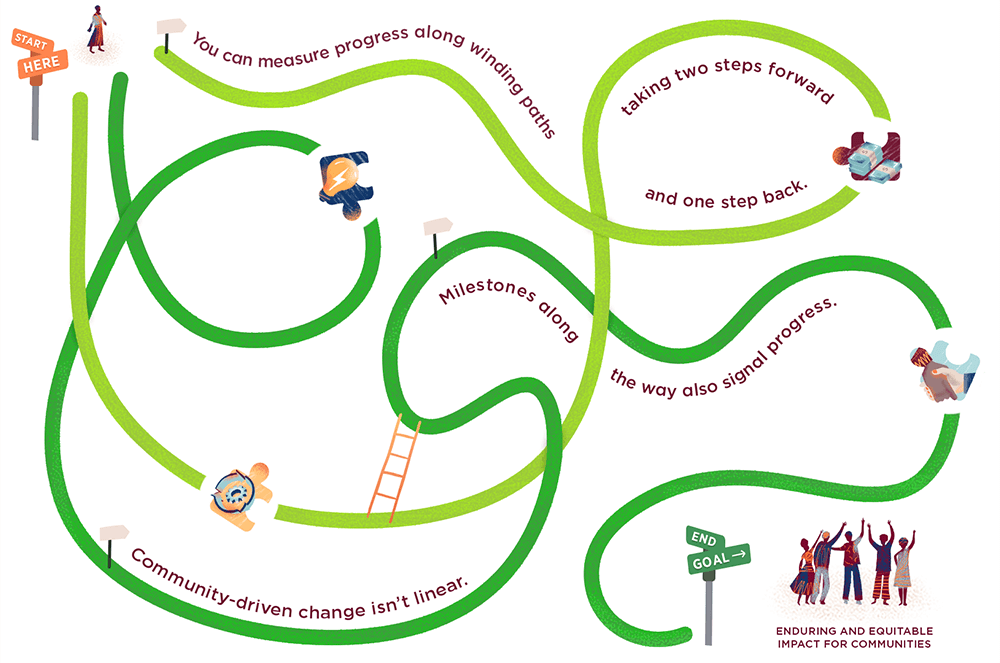Measuring Community-Driven Change: Resources for Funders and Nonprofits
In recent years, there has been a growing recognition in the social sector that putting people at the centre of development initiatives is critical to creating change that lasts. This approach – which we call community-driven change (CDC) – focuses on supporting communities to become architects of their own change and to lead the development and implementation of solutions to challenges they face, in contrast to traditional “top-down approaches” that tell communities the success they should aspire to and how to go about it.
In The Bridgespan Group’s past research, we’ve found compelling evidence that CDC leads to more lasting and equitable change, whether it is empowering rural women in Angrekond village in Maharashtra, India, or reducing the risk of HIV in adolescents in South Kamagambo, Kenya. Yet the shift towards this approach has been slow, especially in Asia and Africa. It is not that funders and nonprofits aren’t interested – in fact, most understand how CDC could help sustain results over time. But there is still a persistent uncertainty around how to integrate a CDC approach in their work. More specifically, the challenge we observed repeatedly was a concern around how to track progress and evaluate CDC results effectively.
We set out to learn more about that challenge over the past year, as part of a multi-year initiative with nine anchor partners.1 We learnt that since CDC focuses on the process of building power, assets, and equity & inclusion, it needs an unconventional approach when it comes to assessing progress. Many traditional measurement approaches assume progress will advance on a linear path: a straight line from inputs (that is, the activities a programme undertakes) to programmatic goals (say, how many schools have been built in the community). This assumption doesn’t consider whether and how power, assets, and equity & inclusion are being strengthened in a community.
CDC is also a non-linear process: it is centred on the needs of the community, not a programme. As the community’s needs evolve as their power and assets are strengthened, so do the goals or measures of success. That is why the process of measuring CDC is more of a journey, rather than a race to a destination. It requires iteration, flexibility, and a willingness to acknowledge that the results might not be what you expected when you started.
What Assessing Progress on Community-Driven Change Looks Like

Taking these aspects of CDC into consideration, and to address the need funders and nonprofits shared for practical guidance around measuring CDC, we sought to address two key questions in this year’s research: How can assessing progress on CDC be easier for both funders and nonprofits, so that more of them can convert their interest in CDC into action? And how can it be done in a way that doesn’t necessarily require an overhaul of existing frameworks, but can be used in conjunction with them, to integrate more of a CDC approach in development programmes?
To answer these questions, we interviewed over 50 practitioners, including funders, nonprofits, and intermediaries in India and Africa, who work directly or indirectly with communities, and asked them whether and how they have integrated a CDC approach in their work.2 We have compiled our research into a set of resources to create a starting point for those curious about community-driven change and interested in exploring how to apply the approach to their work. We hope these resources inspire more funders and nonprofits to adapt CDC and to support communities in taking charge of their own change.
CDC is enabled when a community strengthens its...
Power: The community's sense of collective ownership of the goals it wants to achieve and its ability to participate in decision-making to achieve those goals.
Assets: Both knowledge assets, such as technical know-how and leadership capabilities to improve livelihoods, as well as access to resources like government entitlements, financial capital, and public and private networks.
Equity & Inclusion: Social cohesion and balance of power within the community, especially with respect to historically marginalised groups.
You can also download a visual primer on what Power, Assets, and Equity & Inclusion can look like in communities.
Explore the Resources:
How to Assess Community-Driven Change: Four Guiding Principles for Funders and Nonprofits
Creating measurement, evaluation, and learning (MEL) frameworks for locally led or community-led development programmes can be challenging since they need to capture large-scale, normative shifts over only programmatic goals. This resource outlines four best practices to keep in mind while designing an assessment framework for CDC.
Community-Driven Change Assessment Toolkit
This practical guide walks funders and nonprofits through the details of how to capture the process of strengthening power, assets, and equity & inclusion in the community. Specifically, it covers:
- Themes and sub-themes that constitute power, assets, and equity & inclusion
- Guidance on creating an impact assessment framework for CDC, with a customisable template and references for specific thematic areas
- A detailed “Indicators Bank” of metrics (outputs, intermediate outcomes, and ultimate outcomes) to track progress on power, assets, and equity & inclusion
- Guidance on data collection and evaluation
For additional resources and insights from our previous research, please visit our Community-Driven Change resource page.
Footnotes
- Our anchor partners include the Children’s Investment Fund Foundation, Conrad N. Hilton Foundation, Global Alliance for Communities, H&M Foundation, Humanity United, Rohini Nilekani Philanthropies, Swades Foundation, Target Foundation, and Veddis Foundation.
- Some of the individuals and organisations featured and interviewed in these resources are past or current clients of The Bridgespan Group.
